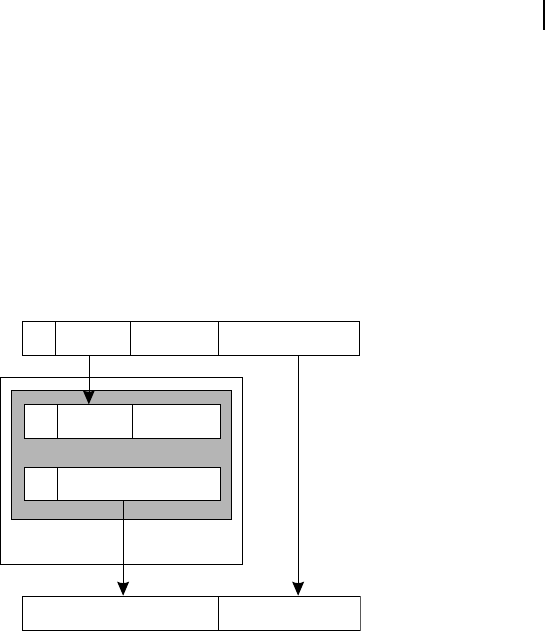
MIPS R4000 505
The tag check for load/store type instructions and branch type instructions are performed at the TC
stage. Finally, during WB stage, the result of operation is written back to the register for register to reg-
ister instructions. No operation is performed at this stage for branch type instructions.
E.9 MEMORY MANAGEMENT
MIPS R4000 is provided with an ef cient on-chip memory management unit to help the processor to
translate the virtual address to physical address using its TLB. Schematically, it is represented through
Figure E.8 .
Figure E.8 Address conversion scheme of R4000 (Courtesy: MIPS Technologies, Inc.)
Virtual address
G ASID VPN
G
G
ASID VPN
PFN
Offset
TLB entry
TLB
PFN
Physical address
Offset
MIPS R4000 takes the help of its Translation Lookaside Buffer (TLB) for generating the physical
address from the virtual address. The method of translation is slightly different in 32-bit mode with
respect to 64-bit mode. First we discuss the general procedure adopted in both cases and then highlight
the related differences. The reader may note that in 32-bit mode, the available virtual memory is 2 GB
while in 64-bit mode it is 1 TB.
The TLB is a fully set associative memory capable of accommodating 48 different entries. Note that
each of the entry provides a mapping of an odd-even page-pair. Therefore, 48 entries within TLB are
capable of representing 48 page-pairs or 96 pages. At this stage we must keep in mind that the page size of
MIPS R4000 is variable and may be xed as any one of 4K, 16K, 64K, 256K, 1M, 4M and 16M locations.
When a virtual address to be converted to its physical address, each TLB entry is checked simultane-
ously for a match with the virtual address, extended by an address space identi er (ASID, stored in the
EntryHi register). If the entry is found within the TLB (a match or a hit), then the page frame number
(PFN) is available from the TLB, which, along with the offset, denotes the physical address. Note that
the offset part of the virtual address does not pass through TLB. If it is not found within TLB (mismatch
or miss), then the TLB is updated from the page table resident within memory. The new information
may be written at a software-selected location or at a random location identi ed by the system hardware.
An interesting fact may be noted here that in case of multiple matches, which would generate error, the
TLB is temporarily disabled by setting the TS (TLB-Shutdown) bit of the status register.
Z05_GHOS1557_01_SE_C20_App_E.indd 505Z05_GHOS1557_01_SE_C20_App_E.indd 505 4/29/11 5:46 PM4/29/11 5:46 PM
..................Content has been hidden....................
You can't read the all page of ebook, please click here login for view all page.
